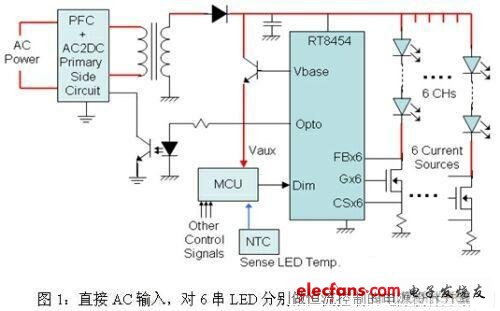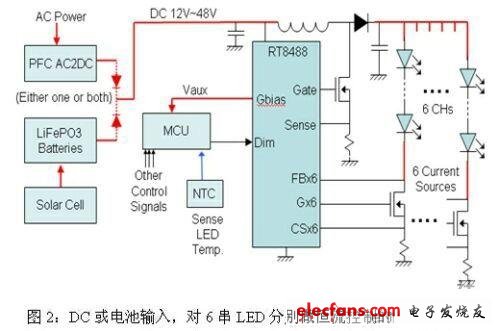LED street light is a very important application in LED lighting. Under the premise of energy saving, the trend of LED street lamps replacing traditional street lamps is becoming more and more obvious. There are many designs of LED street light power supplies on the market. Early design pays more attention to the pursuit of low cost; in the near future, consensus is gradually formed, and high efficiency and high reliability are the most important.
This article is mainly for the application of several different LED street lights, put forward a suitable architecture, and analyze its advantages and disadvantages, so that readers can find the most suitable solution according to the specific conditions and types of street lights designed.
Option 1: Direct AC input, constant current control for 6 strings of LEDs
Among the several schemes introduced in this article, this one should be the scheme with the highest efficiency and the lowest circuit cost (Figure 1). Directly use the photocoupler to retrospectively control the primary side circuit and adjust the output voltage. Compared with other traditional solutions, this solution has less switching losses. The voltage of CS is fixed at 0.25V, and the constant current control is performed on the six strings of LEDs respectively. The IC will detect the position of FB and fix the lowest string of LEDs at 0.5V. At this time, because the sum of the Vf values ​​of the LED strings is different, the resulting voltage drop will fall on the MOS tube, causing some losses. If the LED is generally screened by Vf sub-BIN, the loss should be controlled within 2%, which is less than the general switching loss. The advantages of this solution are high efficiency and low cost. The disadvantages are AC input and more research and development costs. This solution is suitable for street lights that can be directly input with AC.

Option 2: DC or battery input, constant current control for 6 strings of LEDs
It uses a multi-string boost structure design, LED driving method is similar to the previous one, the difference is that the AC input is changed to DC or battery input (Figure 2). As long as the appropriate MOS tube is selected for the design of the low-voltage side sensor, the LED can string a considerable number. Compared with the AC input scheme, the design is relatively simple. However, due to the addition of a boost switch, the efficiency is relatively low. The advantages of the scheme are simple design, low circuit cost, and the disadvantage is low efficiency. It is suitable for solar cells or street lights input through adapters.

Melt Pressure Sensor,Differential Pressure Sensor,High Temperature Melt Pressure Sensor,Explosion-Proof Melt Pressure Sensor
Xiaogan Yueneng Electronic Technology Co., Ltd. , https://www.xyeloadcell.com